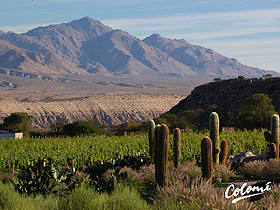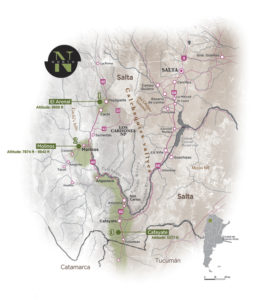Jo Ahearne, MW
There can be many elements akin to a competitive sport in the world of wine.
I’ve got smaller/bigger barrels than you; or newer/older oak; bigger vineyards or smaller; more specific vineyards surrounded by dry stone walls; biggest bottles in the world; oldest vintages in the world; most complete vertical collection…I could go on.
But the one competition that Argentina wins is highest vineyard. Hands down, not even needing a ‘hand of god‘ to help them (well, to think of it, ‘the hand of whoever’s god‘ did actually make the vineyard land so, in essence, ‘the hand of god‘ helped them on this one as well!)

So why the obsession with all this height?
For each 100 metres you gain in altitude, you lose 1oC in temperature. That’s a powerful equation. So at sea level if you have a scorching 35oC heat at 1,000m you have a balmy 25oC. Grapes need sunshine and not so much heat so it’s just a bit of a bugger that with lots of sunshine you usually get lots of heat.
In addition, altitude encourages more diurnal temperature variation. That’s to say it cools down a lot during the night. Grapes, being a bit like people, need a bit of cool at night to ‘rest’. It prevents undue metabolism of the precious acids that keeps the resulting wines fresher. The other difference lies in higher UV levels, which produce thicker skins with more colour and better quality tannins (smoother and less astringent). To be able to temper that heat by looking to the skies really helps to balance your wine.
So to start quite literally at the top, let’s have a look at the Amalaya Torrontes-Riesling

The winery behind this wine is Colomé. It boasts the world’s highest commercial vineyards and is found in the northerly Salta region of Argentina. I’ve visited a couple of time to blend wines there and it is truly ‘out of this world’. The Calchaquí Valley is a good four hours’ drive from the city of Salta itself but what a drive! The vistas are mesmerising – one minute you’re in a cowboy film and the next you’re in a galaxy far, far away.
They’ve thoughtfully built a boutique hotel there and even their own hydro-electric system that powers the whole village. The chef at the hotel specialises in High Andean cuisine, which goes way beyond a bit of quinoa salad but it was where I first learnt that the Spanish banned the locals from eating quinoa because it gave them too much strength to fight them…
In 1999, they purchased the 350-hectare El Arenal farm, at 2,600 metres altitude, on which they planted 30ha of Malbec. The Colomé property itself is a massive 39 000ha, of which 11ha were old vineyards (60–150 years’ old). Altogether, there are now 70 hectares of vines at Colomé. There is also an experimental vineyard at El Arenal at an altitude of 3,002 metres. A further 10 hectares are planted in Cafayate.
Amalaya translates to ‘Hope for a Miracle’ in the Calchaquí language. For this wine Colome have 220 hectares of land with approximately 35 hectares of Malbec, Torrontés, Cabernet Franc and Syrah in production, and another 90 hectares in development. Grapes come from three vineyards: Finca Las Mercedes, with deep sandy soils; Finca La Brava, with rocky soils; and Finca Amalaya, with fractured rocky soils and stones of varying sizes. Like the wines of Bodega Colomé, the grapes benefit from being planted at altitude. The vines are drip irrigated using mountain runoff water stored in reservoirs, because the average annual rainfall is only 150mm.
All of this goes into making a much awarded wine – Silver – Sommelier Wine Awards 2014, Gold – Decanter World Wine Awards 2014, 2013, 2012, 2011, Trophy – Torrontes and Best Argentinean White- International Wine Challenge 2014. Fresh and fruit driven with delicious grapefruit and perfumed Muscat-like aromas from the Torrontes alongside the more zesty lemon of the Riesling.
This is the extreme of high-altitude viticulture but there are many other places that use the tempering qualities of mountain air to help provide freshness and balance to their wines. Here are just a few of my favourites:
CANICATTÌ NERO D’AVOLA LA FERLA
Sicily, Italy £6.50
This comes from higher altitude vineyards in Sicily, which gives it the freshness often missing in warmer climates. It packs a punch with its lifted sweet nose and great concentration for the price. Lovely velvet texture and full of spice with damson plums sprinkled with dark chocolate – 90% coco solids is not your ordinary chocolate! I defy anyone not to wonder where the bottle went…
BORSAO SELECCIÓN TINTO
Campo de Borja, Spain £9.50
The elder brother of the Borsao Garnacha, which shows elements of sophistication that you’d expect from an elder sibling. Wonderful concentration with a lovely velvet texture and more savoury elements mingling with a pure plum fruitiness that is truly scrumptious.
BORSAO GARNACHA
Campo de Borja, Spain £5.50
A Gold Medal at the Sommelier Wine Awards doesn’t come easy. But this wine deserves a double Gold for pure value for money. Buy a case and have a glass whenever you feel like it. Stirring the ragu? That’ll do nicely. Lighting the BBQ? Fabulous. Got a party coming? Can’t beat this one. Fresh, smooth, rapsberry fruit with a hint of olives and white pepper. Job done.
MALBEC, PUNTO FINAL, RENACER
Mendoza, Argentina £10.50
Bold blackberry fruit nose and palate – this is really rounded and juicy, with lovely spice notes, some black cherry and a hint of dark chocolate.
CHÂTEAU MUSAR JEUNE RED
Bekaa Valley, Lebanon £12.00
Iconic as it is intriguing, this unique take on the classic Musar blend has a fascinating balance of intensity and freshness; a wine expertly crafted by a world class producer.
GRAN CABERNET FRANC ‘XI’ PULENTA
Mendoza, Argentina £22.00
A rare example of (genuinely) top quality Cabernet Franc. Bright, red fruit aroma, typical of the grape variety. But what follows is pure Argentina – richness, ripeness and a creamy, succulent texture. The whole package as self-confident and impressive as the bottle itself.

